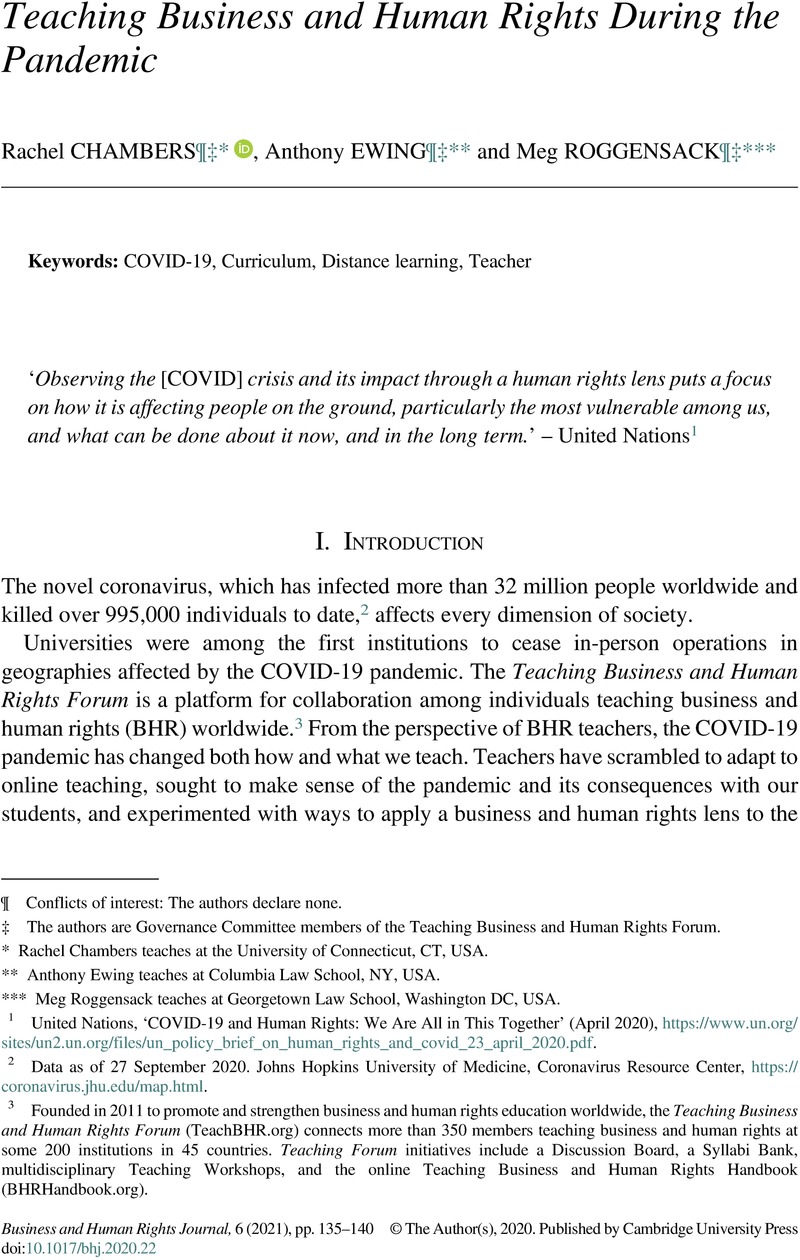No CrossRef data available.
Published online by Cambridge University Press: 09 November 2020

Conflicts of interest: The authors declare none.
The authors are Governance Committee members of the Teaching Business and Human Rights Forum.
Rachel Chambers teaches at the University of Connecticut, CT, USA.
Anthony Ewing teaches at Columbia Law School, NY, USA.
Meg Roggensack teaches at Georgetown Law School, Washington DC, USA.
1 United Nations, ‘COVID-19 and Human Rights: We Are All in This Together’ (April 2020), https://www.un.org/sites/un2.un.org/files/un_policy_brief_on_human_rights_and_covid_23_april_2020.pdf.
2 Data as of 27 September 2020. Johns Hopkins University of Medicine, Coronavirus Resource Center, https://coronavirus.jhu.edu/map.html.
3 Founded in 2011 to promote and strengthen business and human rights education worldwide, the Teaching Business and Human Rights Forum (TeachBHR.org) connects more than 350 members teaching business and human rights at some 200 institutions in 45 countries. Teaching Forum initiatives include a Discussion Board, a Syllabi Bank, multidisciplinary Teaching Workshops, and the online Teaching Business and Human Rights Handbook (BHRHandbook.org).
4 Teaching Business and Human Rights Forum, ‘Teaching Remotely’, https://teachbhr.org/resources/teaching-remotely/.
5 ‘Teaching Resources: Human Rights and the COVID-19 Pandemic’, Teaching Business and Human Rights Handbook (Teaching Business and Human Rights Forum, 2020), https://teachbhr.org/resources/teaching-bhr-handbook/teaching-notes/human-rights-and-the-covid-19-pandemic/teaching-resources/.
6 Anthony Ewing, Jamie O’Connell and Nina Gardner, ‘Teaching Note: Human Rights and the COVID-19 Pandemic’ in Teaching Business and Human Rights Handbook (Teaching Business and Human Rights Forum, 2020), https://teachbhr.org/resources/teaching-bhr-handbook/teaching-notes/human-rights-and-the-COVID-19-pandemic/.
7 Guiding Principles on Business and Human Rights: Implementing the United Nations ‘Protect, Respect and Remedy’ Framework, Report of the Special Representative of the Secretary-General on the issue of human rights and transnational corporations and other business enterprises, UN doc. A/HRC/17/31 (adopted 21 March 2011), http://www.ohchr.org/Documents/Publications/GuidingPrinciplesBusinessHR_EN.pdf.
8 The Inter-American Commission on Human Rights, for example, has called attention to attacks against human rights defenders in the context of pandemic-related emergency measures taken by countries around the region, noting that ‘States … have an obligation to protect the lives and personal integrity of human rights defenders when these are at risk, even if such risk stems from the actions of non-State actors’. Inter-American Commission on Human Rights (IACHR), ‘IACHR Calls on States to Protect and Preserve the Work of Human Rights Defenders During the COVID-19 Pandemic’, Press Release (5 May 2020), http://www.oas.org/en/iachr/media_center/PReleases/2020/101.asp.
9 UN Human Rights Committee, General Comment No. 29: Article 4: Derogations during a State of Emergency (31 August 2001), https://www.refworld.org/docid/453883fd1f.html; UN Human Rights Committee, General Comment No. 27: Article 12 (Freedom of Movement) (2 November 1999), https://www.refworld.org/docid/45139c394.html.
10 American Association for the International Commission of Jurists, The Siracusa Principles on the Limitation and Derogation Provisions in the International Covenant on Civil and Political Rights (April 1985), https://www.icj.org/wp-content/uploads/1984/07/Siracusa-principles-ICCPR-legal-submission-1985-eng.pdf.
11 See, e.g., Human Rights Watch et al, ‘Joint Civil Society Statement: States Use of Digital Surveillance Technologies to Fight Pandemic Must Respect Human Rights’ (2 April 2020), https://www.hrw.org/news/2020/04/02/joint-civil-society-statement-states-use-digital-surveillance-technologies-fight#; OneZero, ‘We Mapped How the Coronavirus is Driving New Surveillance Programs Around the World’ (9 April 2020), https://onezero.medium.com/the-pandemic-is-a-trojan-horse-for-surveillance-programs-around-the-world-887fa6f12ec9.
12 For examples of company pandemic responses, see, e.g., Salil Tripathi, ‘Companies, COVID-19 and Respect for Human Rights’, Business and Human Rights Journal (2020), 1–9. doi: 10.1017/bhj.2020.16. See also Business and Human Rights Resource Centre COVID-19 Action Tracker: https://covid19.business-humanrights.org/en/tracker/.
13 See, e.g., Anthony Ewing, ‘Integrating Human Rights into Crisis Planning’, A Good Practice Note endorsed by the United Nations Global Compact Human Rights and Labour Working Group (6 October 2015), https://logosconsulting.net/wp-content/uploads/2015/11/Integrating-HR-Into-Crisis-Planning-GPN-Oct-2105.pdf.
14 Teaching Note, note 6.